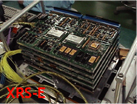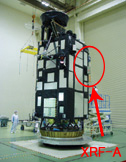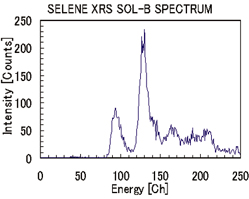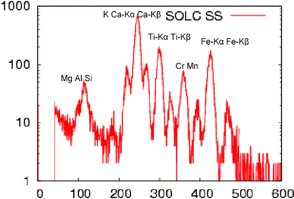Scientific Objectives
The XRS will globally determine major elemental composition (Mg, Al, Si, Ca, Ti, Fe, etc.) of the lunar crust with high spatial resolution.
The XRS will identify a rock type for each lunar geologic feature and survey its regional variation patterns.
=> to study the formation and evolution of lunar crust for understanding the lunar origin and evolution.
| XRF-A Lunar XRF Detector |
SOL-B Solar X-ray Monitor |
SOL-C XRF Calibrator |
|
|---|---|---|---|
| Detector | CCD x 16 | SiPIN Diode x 2 | CCD x 1 |
| Detection Area | 100 cm2 | Pinhole size | 6 cm2 |
| Field of View | 12 x 12 deg | 180 x 90 deg | 180 x 90 deg |
| Footprint Resolution | 20km (@ 100km) | - | - |
| Energy Range | 0.7 -10KeV | 1 -20KeV | 0.7 -10KeV |
| Energy Resolution | < 180eV (@-50degC, Fe55) |
< 500eV (@Fe55) |
< 160eV (@-50degC, Fe55) |
| Operating Temperature | < -40degC | < 0degC | < -40degC |
| ADC | 12bit | 8bit | 12bit |
| Mission Packet | EVENT, SPCTR CHECK, IMAGE |
PIN-HIST, CAL | EVENT, SPCTR CHECK, IMAGE |




Solar X-ray induced Remote XRF spectrometry
Irradiation of solar X-rays excites atoms of the uppermost surface materials. Those excited atoms then transfer into ground state with emitting X-rays characteristic to each element. X-ray spectroscopy of sunlit surface thus provides information on elemental composition, along with concurrent monitoring of incident solar x-rays.
Determine the elemental abundance and rock-type of the lunar crust
and comparison with GRS
| XRS | GRS | |
|---|---|---|
| Mg/Si | < 10km | < 50km |
| Al/Si | < 10km | < 50km |
| Fe/Si | < 30km | |
| Mg# | < 50km | |
| Ti/Si | < 50km | |
| Ca/Si | < 50km | |
| K-Na-Ca | < 100km | |
| Th, U, K Volatile/Refractory |
N/A | < 30km < 30km |
Result of component test


Manabu Kato
Department of Planetary Science,
JAXA/ISAS